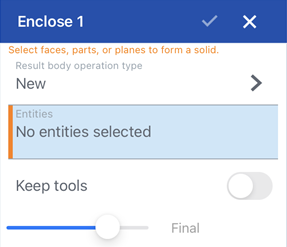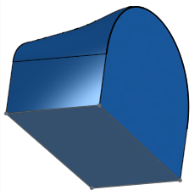 Enclose
Enclose
![]()
![]()
![]()
Create a part by selecting all boundaries surrounding an empty space to form a solid. Use any set of surfaces and solids (including planes and faces) that intersect each other or connect at a boundary to create a volume. Create a new part or modify an existing one by adding, removing, or intersecting parts.
Enclose creates a part by enclosing a volume with faces, planes, surfaces, or parts as the boundaries.
The selected entities must intersect or connect at a boundary to form a solid volume.
Start a new enclosed feature.
Select the entities to enclose in the graphics area.
Check keep tools to preserve the surfaces and parts used for the enclosed feature. Otherwise, they are deleted.
The enclosed feature includes Boolean options to tailor the result further.
New creates a new part.
Add adds the enclosed volume to existing parts specified in the merge scope.
Remove subtracts the enclosed volume from existing parts.
Intersect preserves the intersecting volume between the enclosed volume and existing parts.
- Click
 .
.

- Select a Result operation type:
- New - Create new material that results in a new part.
- Add - Create material added to the existing material.
- Remove - Take material away from a part.
- Intersect - Leave material only where intersections exist.
-
Select the entities that surround the volume to be enclosed. Entities must intersect.
Optionally select Keep tools to retain the selected entities at the creation of the new part. If Keep tools is not selected, those owning parts of any selection (not from a sketch or a plane) will be deleted.
-
Click
 .
.
In the first image, the surfaces and the plane are selected as boundaries. In the second image, the surfaces are deleted (no Keep tools) and the volume bounded by the plane and surfaces is now a solid part.


Result operation types
An original box part with revolved surface and 2 planes is shown in the top image. The resultant operation types are displayed below: New (middle left), Add (middle right), Remove (bottom left), and Intersect (bottom right). For Add, Remove, and Intersect, the box part is used as the Merge scope.

Keep tools
When Keep tools is selected, the surfaces remain and the volume is a solid part.

This lists the collection of surface feature tools. This is not an exhaustive list. Additional Feature tools may be used when modeling surfaces. See Surfacing for additional information.
-
 Thicken - Add depth to a surface. Create a new part or modify an existing one by giving thickness to a surface and converting it to a solid, adding or removing material from an existing part or surface, or intersecting parts in its path.
Thicken - Add depth to a surface. Create a new part or modify an existing one by giving thickness to a surface and converting it to a solid, adding or removing material from an existing part or surface, or intersecting parts in its path. -
 Enclose - Create a part by selecting all boundaries surrounding an empty space to form a solid. Use any set of surfaces and solids (including planes and faces) that intersect each other or connect at a boundary to create a volume. Create a new part or modify an existing one by adding, removing, or intersecting parts.
Enclose - Create a part by selecting all boundaries surrounding an empty space to form a solid. Use any set of surfaces and solids (including planes and faces) that intersect each other or connect at a boundary to create a volume. Create a new part or modify an existing one by adding, removing, or intersecting parts. -
 Fillet - Round sharp interior and exterior edges and define as a standard constant radius, more stylized conic, or variable by selecting Edge fillet. Optionally apply a Full round fillet to create a seamless blend of one or more faces between two opposing sides.
Fillet - Round sharp interior and exterior edges and define as a standard constant radius, more stylized conic, or variable by selecting Edge fillet. Optionally apply a Full round fillet to create a seamless blend of one or more faces between two opposing sides. -
 Face blend - Round sharp connected or disconnected interior and exterior faces to create a seamless blend between the faces or detach the blend to create new faces, defining a radius or constant width. Further define the blend cross section (rolling ball or swept profile), symmetry, control, trim, constraints, and limits.
Face blend - Round sharp connected or disconnected interior and exterior faces to create a seamless blend between the faces or detach the blend to create new faces, defining a radius or constant width. Further define the blend cross section (rolling ball or swept profile), symmetry, control, trim, constraints, and limits. -
 Delete face - Remove geometry from a part. Select whether to heal the surrounding faces (by extending until they intersect), cap the void, or leave the void open. This Direct Editing tool is especially convenient if you don't have the parametric history of the part, as is often the case with an imported part.
Delete face - Remove geometry from a part. Select whether to heal the surrounding faces (by extending until they intersect), cap the void, or leave the void open. This Direct Editing tool is especially convenient if you don't have the parametric history of the part, as is often the case with an imported part. -
 Move face - Translate, rotate, or offset one or more selected faces. This Direct Editing tool is especially convenient if you don't have the parametric history of the part, as is often the case with an imported part.
Move face - Translate, rotate, or offset one or more selected faces. This Direct Editing tool is especially convenient if you don't have the parametric history of the part, as is often the case with an imported part. -
 Replace face - Trim a face or extend a face to a new surface. This Direct Editing tool is especially convenient if you don't have the parametric history of the part, as is often the case with an imported part.
Replace face - Trim a face or extend a face to a new surface. This Direct Editing tool is especially convenient if you don't have the parametric history of the part, as is often the case with an imported part. -
 Offset surface - Create a new surface by offsetting an existing face, surface, or sketch region. Set offset distance to 0 to create a copy in place.
Offset surface - Create a new surface by offsetting an existing face, surface, or sketch region. Set offset distance to 0 to create a copy in place. -
 Boundary surface - Create or add a surface specified by its boundary profiles.
Boundary surface - Create or add a surface specified by its boundary profiles. -
 Fill - Create a surface (or a part from surfaces) by defining boundaries and refine the surface with boundary conditions (instead of requiring the use of reference surfaces).
Fill - Create a surface (or a part from surfaces) by defining boundaries and refine the surface with boundary conditions (instead of requiring the use of reference surfaces). -
 Move boundary - Move boundary edges of a surface in order to extend or trim it.
Move boundary - Move boundary edges of a surface in order to extend or trim it. -
 Ruled surface - Create a new or additional ruled surface from an existing edge or multiple edges of a sketch region.
Ruled surface - Create a new or additional ruled surface from an existing edge or multiple edges of a sketch region. -
 Mutual trim - Trim two adjacent surfaces by extending intersections to complete the trim.
Mutual trim - Trim two adjacent surfaces by extending intersections to complete the trim. -
 Constrained surface - Create a surface from a selection of points or mesh data within a specified tolerance. Display deviations and optimize for performance or smoothness.
Constrained surface - Create a surface from a selection of points or mesh data within a specified tolerance. Display deviations and optimize for performance or smoothness.
Create a part by selecting all boundaries surrounding an empty space to form a solid. Use any set of surfaces and solids (including planes and faces) that intersect each other or connect at a boundary to create a volume. Create a new part or modify an existing one by adding, removing, or intersecting parts.
Steps
- Tap the Enclose tool icon (
 ).
).

- Select a Result operation type:
- New - Create new material that results in a new part.
- Add - Create material added to the existing material.
- Remove - Take material away from a part.
- Intersect - Leave material only where intersections exist.
- Select the entities that surround the volume to be enclosed. Entities must intersect.
Optionally select Keep tools to retain the selected entities at the creation of the new part. If Keep tools is not selected, those owning parts of any selection (not from a sketch or a plane) will be deleted.
-
Tap
 .
.
Examples
In the first image, the surfaces and the plane are selected as boundaries. In the second image, the surfaces are deleted (no Keep tools) and the volume bounded by the plane and surfaces is now a solid part.


Keep tools
When Keep tools is selected, the surfaces remain and the volume is a solid part:

Create a part by selecting all boundaries surrounding an empty space to form a solid. Use any set of surfaces and solids (including planes and faces) that intersect each other or connect at a boundary to create a volume. Create a new part or modify an existing one by adding, removing, or intersecting parts.
Steps
- Tap
 .
.

- Select a Result operation type:
- New - Create new material that results in a new part.
- Add - Create material added to the existing material.
- Remove - Take material away from a part.
- Intersect - Leave material only where intersections exist.
- Select the entities that surround the volume to be enclosed. Entities must intersect.
Optionally select Keep tools to retain the selected entities at the creation of the new part. If Keep tools is not selected, those owning parts of any selection (not from a sketch or a plane) will be deleted.
-
Tap
 .
.
Examples
In the first image, the surfaces and the plane are selected as boundaries. In the second image, the surfaces are deleted (no Keep tools) and the volume bounded by the plane and surfaces is now a solid part.


Keep tools
When Keep tools is selected, the surfaces remain and the volume is a solid part.
